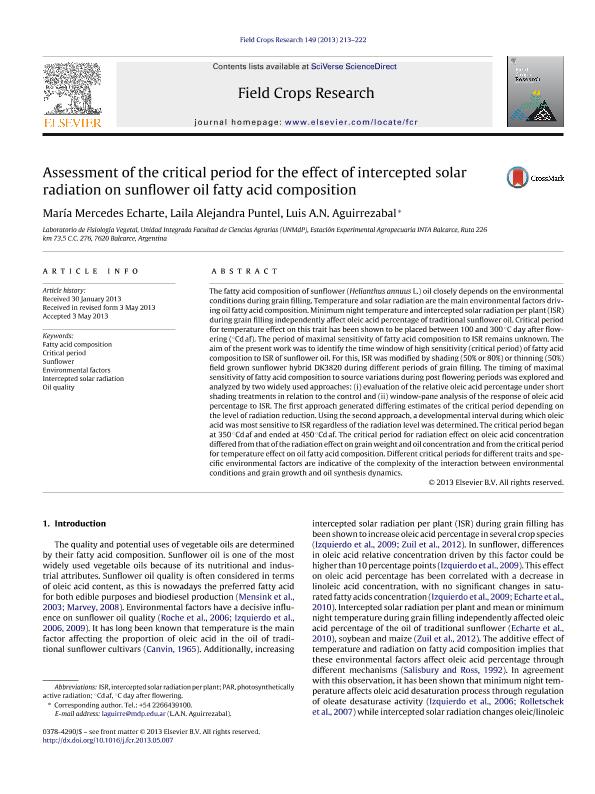Mostrar el registro sencillo del ítem
dc.contributor.author
Echarte, Maria Mercedes

dc.contributor.author
Puntel, Laila Alejandra

dc.contributor.author
Aguirrezábal, Luis Adolfo Nazareno

dc.date.available
2016-01-05T19:12:47Z
dc.date.issued
2013-08-01
dc.identifier.citation
Echarte, Maria Mercedes; Puntel, Laila Alejandra; Aguirrezábal, Luis Adolfo Nazareno; Assessment of the critical period for the effect of intercepted solar radiation on sunflower oil fatty acid composition; Elsevier; Field Crops Research; 149; 1-8-2013; 213-222
dc.identifier.issn
0378-4290
dc.identifier.uri
http://hdl.handle.net/11336/3339
dc.description.abstract
The fatty acid composition of sunflower (. Helianthus annuus L.) oil closely depends on the environmental conditions during grain filling. Temperature and solar radiation are the main environmental factors driving oil fatty acid composition. Minimum night temperature and intercepted solar radiation per plant (ISR) during grain filling independently affect oleic acid percentage of traditional sunflower oil. Critical period for temperature effect on this trait has been shown to be placed between 100 and 300. °C day after flowering (°Cd. af). The period of maximal sensitivity of fatty acid composition to ISR remains unknown. The aim of the present work was to identify the time window of high sensitivity (critical period) of fatty acid composition to ISR of sunflower oil. For this, ISR was modified by shading (50% or 80%) or thinning (50%) field grown sunflower hybrid DK3820 during different periods of grain filling. The timing of maximal sensitivity of fatty acid composition to source variations during post flowering periods was explored and analyzed by two widely used approaches: (i) evaluation of the relative oleic acid percentage under short shading treatments in relation to the control and (ii) window-pane analysis of the response of oleic acid percentage to ISR. The first approach generated differing estimates of the critical period depending on the level of radiation reduction. Using the second approach, a developmental interval during which oleic acid was most sensitive to ISR regardless of the radiation level was determined. The critical period began at 350. °Cd. af and ended at 450. °Cd. af. The critical period for radiation effect on oleic acid concentration differed from that of the radiation effect on grain weight and oil concentration and from the critical period for temperature effect on oil fatty acid composition. Different critical periods for different traits and specific environmental factors are indicative of the complexity of the interaction between environmental conditions and grain growth and oil synthesis dynamics.
dc.format
application/pdf
dc.language.iso
eng
dc.publisher
Elsevier

dc.rights
info:eu-repo/semantics/openAccess
dc.rights.uri
https://creativecommons.org/licenses/by-nc-nd/2.5/ar/
dc.subject
Critical Period
dc.subject
Environmental Factors
dc.subject
Fatty Acid Composition
dc.subject
Intercepted Solar Radiation
dc.subject
Sunflower
dc.subject.classification
Agronomía, reproducción y protección de plantas

dc.subject.classification
Agricultura, Silvicultura y Pesca

dc.subject.classification
CIENCIAS AGRÍCOLAS

dc.title
Assessment of the critical period for the effect of intercepted solar radiation on sunflower oil fatty acid composition
dc.type
info:eu-repo/semantics/article
dc.type
info:ar-repo/semantics/artículo
dc.type
info:eu-repo/semantics/publishedVersion
dc.date.updated
2016-03-30 10:35:44.97925-03
dc.journal.volume
149
dc.journal.pagination
213-222
dc.journal.pais
Países Bajos

dc.journal.ciudad
Amsterdam
dc.description.fil
Fil: Echarte, Maria Mercedes. Instituto Nacional de Tecnología Agropecuaria. Centro Regional Buenos Aires. Estación Experimental Agropecuaria Balcarce. Area de Investigación en Agronomía; Argentina. Universidad Nacional de Mar del Plata. Facultad de Ciencias Agrarias; Argentina. Consejo Nacional de Investigaciones Científicas y Técnicas. Centro Científico Tecnológico Mar del Plata; Argentina
dc.description.fil
Fil: Puntel, Laila Alejandra. Universidad Nacional de Mar del Plata. Facultad de Ciencias Agrarias; Argentina. Consejo Nacional de Investigaciones Científicas y Técnicas. Centro Científico Tecnológico Mar del Plata; Argentina
dc.description.fil
Fil: Aguirrezábal, Luis Adolfo Nazareno. Universidad Nacional de Mar del Plata. Facultad de Ciencias Agrarias. Departamento de Producción Vegetal; Argentina. Consejo Nacional de Investigaciones Científicas y Técnicas. Centro Científico Tecnológico Mar del Plata; Argentina
dc.journal.title
Field Crops Research

dc.relation.alternativeid
info:eu-repo/semantics/altIdentifier/doi/http://dx.doi.org/10.1016/j.fcr.2013.05.007
dc.relation.alternativeid
info:eu-repo/semantics/altIdentifier/url/http://www.sciencedirect.com/science/article/pii/S0378429013001792
Archivos asociados
